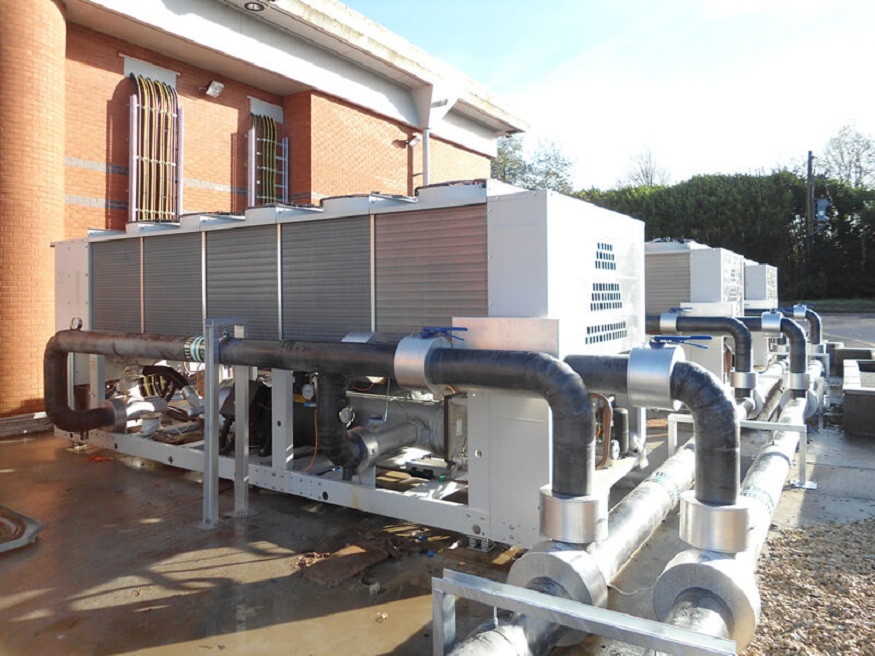A cooling water chiller was designed to help cool the finished product. By using a cooling water chiller, food products could be made in cold rooms or kept at low temperatures without refrigeration or freezing. Cooling water chillers use heat exchangers, recirculation pumps, and heat pumps to reduce the temperature of the process’s incoming and outgoing wastewater streams by 5–15°C (35–59°F).
Water is cooled by exchanging its heat with cold natural water that enters through an opening in the bottom of the tank, where it also evaporates. A water-cooled chiller is a device for removing heat from water or other fluids. Water-cooled chillers are widely used in many industrial applications and can be custom designed to suit specific needs.
Key Knowledge:
A cooling water chiller is a system used to convert heat from refrigerant into cooling water. The idea behind this conversion is to allow for the usage of less expensive cooling water in place of more expensive refrigerant. The system will typically consist of four main parts: the condenser, compressor, expansion valve, and evaporator. These are connected by tubing and piping and require a water source or an outside heat exchanger to be operational. These are often installed outdoors on rooftops where they can take advantage of ambient temperature changes.
What Are Water-Cooled Chiller Systems?
Cooling water chiller systems are a newer alternative to a conventional air-cooled chiller. They use water instead of air to keep the system cool. These air-cooled chiller systems usually require powerful compressors that use refrigerant. All water-cooled chiller systems should be provided with safety features such as interlocks, pressure relief valves, and gauges that monitor the refrigerant pressure inside the compressor. Pressure switches and gauges should be installed to prevent overpressure in case of hydrostatic pressure or high flow condition, in addition to other safety features mentioned earlier.
How Do Water-Cooled Chillers Work?
A water-cooled chiller works similarly to other cooling systems that use compressors and condensers. The chiller is designed with a metal tube attached to the top fin. This metal tube allows for the flow of water through it, which eventually cools the fins. As the refrigerant passes through this metal tube, heat is transferred to the water flowing through it. It takes place until condensation occurs, allowing for some heat recovery. The advantage of using a chiller instead of air as a coolant is that water is much more effective at transferring heat than air.
Water has a higher specific heat capacity than air and an excellent cooling capacity per pound. Therefore, industrial chillers can be either air-cooled or water-cooled. The conversion of heat from electrical energy is the key to how industrial chillers work. An electric motor works as a generator, converting electrical power into mechanical horsepower, which is then converted into cooling power. The mechanical horsepower required to push the compressor provides the movement needed to create refrigeration by converting chemical energy stored in refrigerant into thermal power.
Evaporators:
A cooling water chiller system needs to have a condenser. The condenser is a container that allows for water cooling by an external heat exchanger. This external heat exchanger is typically a copper tube or coil mounted on the evaporator.
Compressors:
Most water-cooled chiller systems involve condensing refrigerant from one refrigerant stream and releasing it in another. If a chiller needs to be efficient, it creates significant energy loss in the air conditioning system since it has to work inefficiently as it refills refrigerant after every cycle. An alternative to this is to use a rotating compressor. This rotating compressor allows the refrigerant to be condensed and released from the same side of the coil. This design reduces energy loss and provides efficient operation.
Water-cooling:
Water cooling can have some disadvantages, such as increasing the temperature of condenser water (which raises the cooling load) or increasing its salinity (leading to corrosion of metal parts). On the other hand, it can recover heat from condensers. Heat exchange in a water-cooled chiller is achieved using a heat exchanger that transfers heat from freshwater exiting the evaporator into cold water or brine entering the evaporator.
Standard Water-Cooled Chiller Sizing Arrangement:
Standard water-cooled chiller sizing arrangements are classified by the amount of heat removed versus the amount of cooling. When a water chiller is selected, the cooling capacity to be provided is multiplied by a coefficient determined by the conditions and conditions expected to prevail during operation. The resulting capacity value will then determine what size of water chiller should be used. Therefore, the first step in selecting a proper chiller is calculating the amount of heat that needs to be removed from your process. The higher this value, the larger or more powerful your chiller will need to be.
Conclusion:
Water-Cooled chillers are an alternative to conventional air-cooled chiller systems, and they use water, electricity, and heat exchange instead of air. It is important to note that even though cooling power is measured in kW/ton, this value cannot be directly applied to it because several factors need to be considered in calculating the required cooling capacity.

